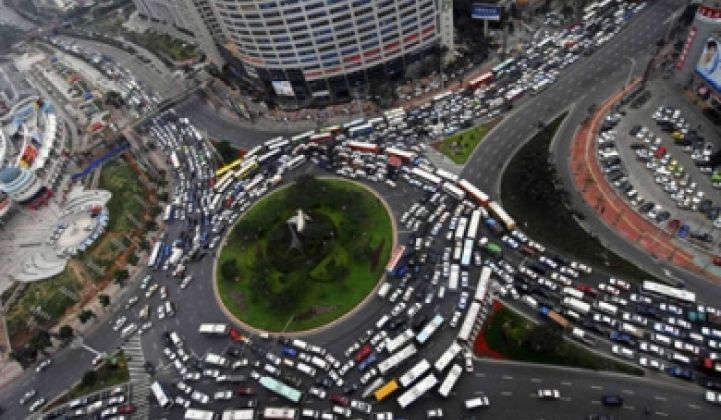Earth is now home to more than one billion vehicles. That number is expected to hit the two-billion mark within 15 years. In January 2009, more cars were sold in China than in the U.S.
Dan Sperling spoke a bit about the future of automobiles at a VC summit hosted by Matt Trevithick of Venrock and organized by Kumar Gogineni of the Cleantech SIG. Trevithick, a partner at Venrock, doesn't strike me as the giddy sort, but said that he was "giddy about the future of the automotive industry" in this current era of innovative expansion in the cyclical automotive industry. His firm is an investor in stealth battery startup Atieva.
Sperling is the co-author of Two Billion Cars: Driving Toward Sustainability, a board member of the California Air Resources Bureau (CARB), a professor of engineering and environmental science & policy at the University of California, Davis, and founding director of UC-Davis’s Institute of Transportation Studies. He has authored 10 books and over 200 technical papers and reports on transportation and energy and has been a guest on The Daily Show.
According to Sperling, there are three pillars in the Zero Emissions Vehicle (ZEV) picture -- vehicles, fuels and VMT (vehicle miles travelled). Although California has the most comprehensive policies in the world to reduce transportation green house gases, the most progress has been on the vehicle front and the least on VMT.
Vehicles: The easiest solutions focus on electric drive vehicles.
Fuels: Sperling believes a key is the adoption of low carbon fuels standards and encouraging consumer use of PEVs.
VMT - Vehicles Miles Travelled: In the U.S., VMT per capita has been going up but is starting to flatten out.
California's "ZEV program has led a tortured life," according to Sperling. Here's a quick overview of the changing mandates and moving targets:
- 1990 mandate adopted 2 percent ZEVs in 1998, 5 percent in 2001, 10 percent in 2003 -- measured as a percentage of new cars.
- 1996 eliminated the 2 percent requirement in favor of a much softer requirement of 3750 BEVs.
- 1998 percentage ZEV requirement reduced by allowing very clean gasoline and other alternative fuels as a partial substitute (PZEV).
- 2001 percentage ZEV requirement reduced by allowing small numbers of Fuel Cell Vehicles (FCVs) to satisfy requirement.
- 2008 new requirement: 12,500 BEVs or 5000 FCVs plus 58,000 PHEVs by 2014.
- 2010 other policies recently adopted in California that encourage the use of ZEVs are GHG standards (analogous to a fuel economy standard) for light duty vehicles ~35 mpg by 2016, assigning an artificially low value of 0 grams of carbon per mile for EVs in calculating the GHG emissions for new cars, and tax credits for EVs, FCVs, and PHEVs (up to $5,000 per vehicle)
Sperling does seem to have a bit of a crush on Fuel Cell Vehicles, despite their refusal to be economical. And he's encountered some controversy -- mostly because some of the private contributions made to the Institute of Transportation Studies at UC Davis have come from car and oil industries. Automakers have long held a fascination with FCVs, again, despite their stubborn refusal to be a reasonable technical or economical choice. In any case, most of the funding for the ITS comes from the government.
During his 2009 appearance on The Daily Show, Sperling said "eventually" the "vast majority" of the two billion cars will be alternative-energy (pure electric, plug-in hybrids, biofueled, and hydrogen fuel cell) vehicles. Jon Stewart predicted that we would all be deceased by the time that "eventually" occurs.
Sperling's book states that "Travelling alone by car is the American way" and "Americans already drive far more than anyone else on the planet. Growth in VMT is far outpacing population growth, economic growth, and additions to road capacity."
So, how do we change driver behavior and get people to drive less? Some of the mechanisms that Sperling's book suggests include:
- Setting a price floor for gasoline
- Greenhouse Gas (GHG) and carbon targets for cities, businesses and developers
- City-center "congestion pricing"
- Increased federal and state taxes on gasoline
- Reward low-carbon consumerism
- Restructure taxes, fees, and other incentives to reduce vehicle usage
All three aspects of the problem -- vehicles, fuel and VMT -- are going to have to shift to make a difference.



